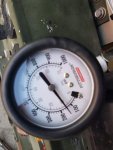- 293
- 29
- 28
- Location
- Odessa/Texas
looks like it bolts up where injector used to be, flange and all.

Sent from my SM-G935P using Tapatalk

Sent from my SM-G935P using Tapatalk
Steel Soldiers now has a few new forums, read more about it at: New Munitions Forums!





We get it, advertisements are annoying!
Sure, ad-blocking software does a great job at blocking ads, but it also blocks useful features of our website like our supporting vendors. Their ads help keep Steel Soldiers going. Please consider disabling your ad blockers for the site. Thanks!

